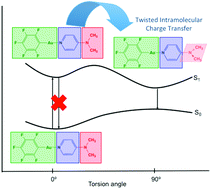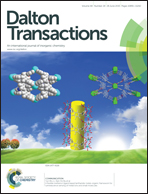The effect of gold(i) coordination on the dual fluorescence of 4-(dimethylamino)pyridine†
Abstract
The reactions of 4(dimethylamino)pyridine (DMAP) with the gold(I) precursors [AuR(tht)] (R = C6F5, C6Cl2F3 or C6Cl5; tht = tetrahydrothiophene) lead to complexes [AuR(DMAP)] (R = C6F5 (1), C6Cl2F3 (2) or C6Cl5 (3)). X-ray diffraction studies of the complexes reveal the presence of discrete molecules in which aurophilic contacts are absent, with π-stacking (1) or hydrogen bond (2) interactions being responsible for the supramolecular arrangements found in the solid state. All complexes display fluorescence in solution in solvents of different polarities such as toluene, chloroform or acetonitrile. In all cases the emission energy is similar to the low-energy Twisted Intramolecular Charge Transfer (TICT) emission of free DMAP. TDDFT calculations confirm that the fluorescence of complexes 1–3 arises from the ICT excited state of bonded DMAP in which a 90° distortion of the pyridine ring and –NMe2 planes is observed. Model calculations based on experimental parameters show a higher degree of polarization of DMAP upon coordination to Au(I) organometallic fragments.


 Please wait while we load your content...
Please wait while we load your content...